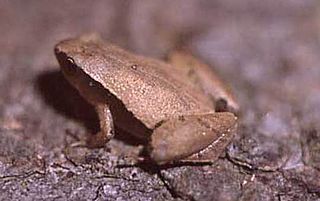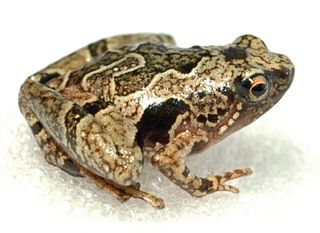
Microhyla ornata, commonly known as the ornate narrow-mouthed frog, ornate narrow-mouthed toad, or ornamented pygmy frog, is a species of microhylid frog found in South Asia. This amphibian is distributed in Kashmir, Nepal, peninsular India and the Andaman and Nicobar Islands, Sri Lanka, and Bangladesh. It was previously considered to be the same species as Microhyla fissipes; therefore, the aforementioned common names can refer to either species.

Microhyla heymonsi, also known as the dark-sided chorus frog or the Taiwan rice frog, is a species of narrow-mouthed frog found in northeastern India, southern China, Taiwan, and Southeast Asia south to the Malay Peninsula and Sumatra as well as the Great Nicobar Island. It was originally described from Taiwan.

Microhyla achatina, commonly known as the Javan chorus frog, Java rice frog, or Javanese narrow-mouthed frog, is a species of narrow-mouthed frog endemic to Java, Indonesia.
Glyphoglossus flavus is a species of frog in the family Microhylidae. It is endemic to Borneo and is known from the Gunung Mulu National Park in Sarawak (Malaysia), Danum Valley Conservation Area in Sabah (Malaysia), and Ulu Temburong National Park in Brunei. Common names Borneo squat frog and yellow burrowing frog have been coined for it.
Glyphoglossus smithi, also known as Smith's squat frog or Smith's burrowing frog, is a species of frog in the family Microhylidae. It is endemic to Sabah and Sarawak in Malaysian Borneo. However, it is likely to occur more widely than currently known and be present in Brunei and Indonesia. The specific name smithi honours Dr Harrison Willard Smith, an American scientist who collected the holotype from the Limbang River district.
Nanohyla annectens, the Larut Hills rice frog, is a species of frog in the family Microhylidae. It is found in Peninsular Malaysia; records from Thailand and elsewhere probably refer to other species. Its natural habitats are evergreen submontane and montane rainforests. It lives on the forest floor and in puddles and breeds in temporary pools. It is locally threatened by habitat loss.
Microhyla borneensis, also known as the Matang narrow-mouthed frog, is a species of microhylid frog found in the Matang Range in Sarawak, Borneo. It was once the smallest known frog from the Old World. Adult males of this species have a snout-vent length (SVL) of 10.6–12.8 mm (0.42–0.50 in), but adult males can reach a maximum of 13 mm (0.51 in),and adult females of this species have a snout-vent length of 16–19 mm (0.63–0.75 in), Tadpoles measure just 3 mm.

The painted chorus frog is a species of frog in the family Microhylidae. It is found in northeast India, Myanmar, southern China, Hong Kong, Taiwan, Thailand, Cambodia, Laos, Vietnam, Peninsular Malaysia, and Singapore. Its natural habitats are subtropical or tropical moist lowland forest, subtropical or tropical moist montane forest, subtropical or tropical moist shrubland, swamps, intermittent freshwater marshes, arable land, plantations, rural gardens, ponds, open excavations, and irrigated land. It is not considered threatened by the IUCN.
Microhyla fusca is a species of frog in the family Microhylidae. It is endemic to Vietnam: it is only known from its type locality, Da Lat on Lang Biang Plateau in southern Vietnam. Its natural habitats are swamps, freshwater marshes, and intermittent freshwater marshes. Its status is insufficiently known.

The palmated chorus frog is a species of frog in the family Microhylidae. It is found in Indonesia and Malaysia. Its natural habitats are subtropical or tropical moist lowland forests, rivers, and freshwater marshes. It is not considered threatened by the IUCN.

Nanohyla perparva is a diminutive species of frog in the family Microhylidae. It is endemic to Borneo and found in Kalimantan (Indonesia), Brunei, and Sabah and Sarawak (Malaysia). The nominal species includes distinct lineages that likely represent different species. Common names least narrow-mouthed frog and Labang forest rice frog have been proposed for this species.

Nanohyla petrigena is a species of frog in the family Microhylidae. It is found in northern and central Borneo and in the Sulu Archipelago of the Philippines. The common names pothole narrow-mouthed frog and Kapit rice frog have been coined for the species.
Microhyla superciliaris is a species of frog in the family Microhylidae. It is found in Peninsular Malaysia and Sumatra (Indonesia). Its type locality is Batu Caves, which have given it its common name, Batu Cave rice frog. The type locality is a limestone crag area surrounded by lowland forest. In Sumatra it is found in forested areas. Breeding presumably takes place is slow-flowing rivers.

Microhyla zeylanica. the Sri Lanka rice frog or Sri Lanka narrow-mouth frog, is a species of frog in the family Microhylidae. It is endemic to Sri Lanka. Its natural habitats are subtropical or tropical moist montane forests, subtropical or tropical high-altitude grassland, swamps, freshwater marshes, and intermittent freshwater marshes. It is threatened by habitat loss.

Shorea faguetiana is a species of plant in the family Dipterocarpaceae. Along with other species in the genus Shorea, it is also called Yellow Meranti. It is native to Borneo, the Malay Peninsula, and Thailand. It is the tallest flowering plant, and second tallest living tree, only after the sequoia, with the largest specimen measuring 100.7 m (330 ft) in height.

Microhyla fissipes is a microhylid frog from East and Southeast Asia, from southern and central China and Taiwan to the Malay Peninsula. It was previously considered to be the same species as Microhyla ornata of South Asia; thus the common names ornate narrow-mouthed frog or ornamented pygmy frog can refer to either species.

Feihyla inexpectata is a species of frog in the family Rhacophoridae. This recently (2014) described species is endemic to Malaysian Borneo and known from its type locality in the Maliau Basin Conservation Area, Sandakan Division, Sabah and from Danum Valley, also in Sabah. Common name Bornean opposite-fingered tree frog has been coined for it.
Rhacophorus borneensis is a species of frog in the family Rhacophoridae. This recently (2013) described species is endemic to Malaysian Borneo where it is known from its type locality in the Maliau Basin Conservation Area, Sandakan Division, Sabah as well as from the Batang Ai National Park, Sarawak. Prior to its description, it was included in Rhacophorus reinwardtii. It is said to be "one of the prettiest frogs of Borneo". Common name Borneo flying frog has been coined for it.











